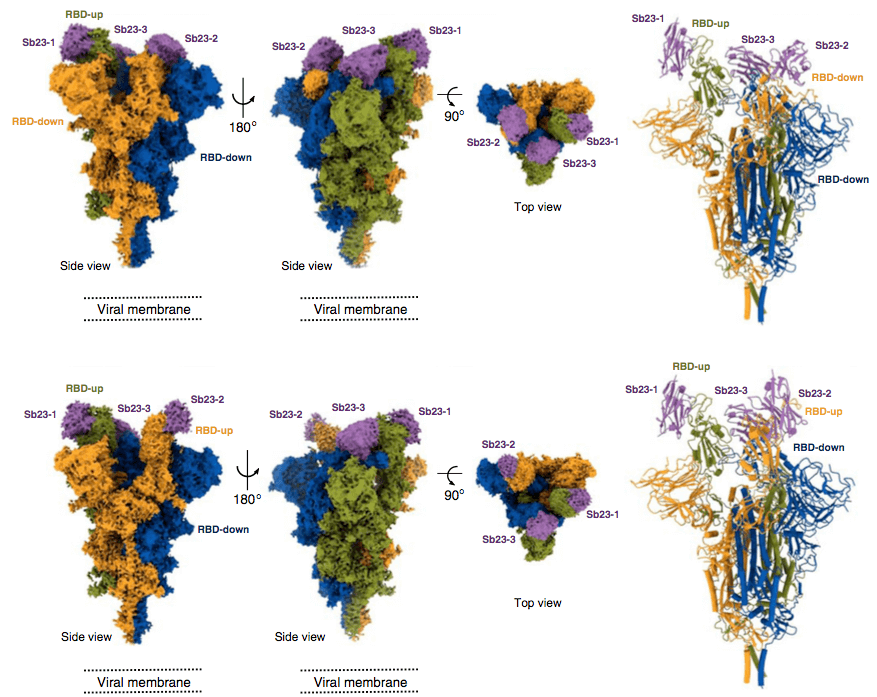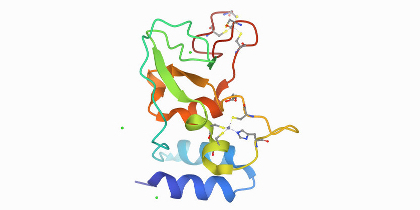Synthetic nanobodies are easy to produce and can effectively neutralize SARS-CoV-2
Published: 2020-11-24

The COVID-19 pandemic has caused a large social and economic burden to society and health care all around the world. COVID-19 is caused by the SARS-CoV-2 virus that, just like its homolog SARS-CoV-1, uses the ACE2 (angiotensin converting enzyme 2) receptor to enter host cells. The virus uses a viral spike protein that, when it binds to the ACE2 receptor, mediates fusion of the viral membrane with the host membrane. The use of therapeutic neutralizing antibodies may be one way to tackle COVID-19. But traditional antibody production and development is known to be time-consuming and costly. An alternative to using human antibodies is to use nanobodies (single-domain antibodies) that can be used as therapeutics; they are small, have increased stability, and are relatively simple to produce. Recent publications have showed that nanobodies can inhibit the binding of the spike protein to ACE2 and neutralize the SARS-CoV-2 virus.
In a collaborative project involving researchers from Sweden, Germany, and South Africa, Tânia Custódio and colleagues (PIs and corresponding authors: Ben Murrell, B. Martin Hällberg and Christian Löw) therefore propose to use nanobodies from a synthetic library (known as sybodies, Sb) that enables a faster and cheaper selection of binders against therapeutic targets. The researchers identified a selection of sybodies directed against the receptor-binding domain (RBD) of SARS-CoV-2 which can compete with ACE2 binding and neutralize SARS-CoV-2 spike pseudovirus. The most promising of these, the Sb23 binds competitively in the ACE2 binding site. These results suggest that synthetic libraries could be platforms for the development of nanobody-based drugs. To facilitate further studies, the researchers have deposited the cryo-EM density maps of SARS-CoV-2 spike glycoprotein with Sb23 bound in the Electron Microscopy Data Bank (EMDB) with accession codes EMD-11616 (1-up) and EMD-11617 (2-up).
The researchers have publicly shared their data in several repositories. The scattering data and models of Sb23, RBD and their complex are deposited into Small Angle Scattering Biological Data bank (SASBDB): entries SASDJF4, SASDJG4, and SASDJH4 respectively. The MST and BLI data were made available on Github. The cryo-EM density maps of SARS-CoV-2 spike glycoprotein with Sb23 bound have been deposited in the Electron Microscopy Data Bank (EMDB) under accession codes listed above. Corresponding models were deposited in the Protein Data Bank (PDB) with accession codes 7A25 (1-up) and 7A29 (2-up). The researchers have also made the sequences of all the selected sybodies available in the Supplementary Data file accompanying the published article. Finally, all other experimental data are available on request from the corresponding authors.
This research was supported in part by an EU H2020 grant (CoroNAb), by project grants from the Swedish Research Council (2018-02381), (2017-6702), (2018-3808), and (2018-03843) and the Knut and Alice Wallenberg Foundation. The project made use of Petra III infrastructure in Hamburg and the 3D-EM Facility for Cryo-EM at the Karolinska Institute.
Article
DOI: 10.1038/s41467-020-19204-y
Custódio, T. F., Das, H., Sheward, D. J., Hanke, L., Pazicky, S., Pieprzyk, J., Sorgenfrei, M., Schroer, M. A., Gruzinov, A. Y., Jeffries, C. M., Graewert, M. A., Svergun, D. I., Dobrev, N., Remans, K., Seeger, M. A., McInerney, G. M., Murrell, B., Hällberg, B. M., & Löw, C. Nat Commun, 11, 5588 (2020).
